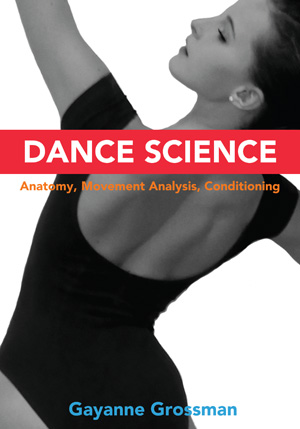Aloha! I would like to share with you a new book in the Dance Wellness field, “Dance Science: Anatomy, Movement Analysis, Conditioning” by Gayanne Grossman, PT. Specific Information on the book is below.
Gayanne has a long background in dance medicine and science, working with injured dancers and teaching anatomy / kinesiology at Muhlenberg College in Allentown, PA, as well as heading up the Performing Arts Wellness Program for Lehigh Valley Health Network. The book is aimed at high school / college-level dancers, and is a terrific resource for those looking to dig deep into the scientific arena, and to stretch their knowledge about the body and safe dance training / technique. It can also serve as an excellent scientific reference manual to keep on hand. Please pass it on! Take care – Jan Dunn, MS, Dance Wellness Editor
For students of human movement, kinesiology, dance science, and dancers, Dance Science takes a positive approach to what a dancer can do to dance better through an understanding of anatomy and an analysis of movement which, in turn, will decrease injury rates. It presents anatomy and motion in a dance-specific way that teaches readers to appreciate and take ownership of their bodies through hands-on experiential activities.The book concludes with an approach to exercise design for enhanced performance integrating the principles of dance science. Accompanied by 90 anatomical illustrations, 30 photographs, and 3 graphs.
320 pages, 7″ x 10″, Paperbound, ISBN 978-087127-388-8 $49.95
Hardbound ISBN 978–087127-387-1 $39.95
Order from: Princeton Book Company, Publishers
Here is an excerpt from the text:
Training Efficiently and Safely for Needed Stability
Start strength training using isometrics. Use varied positions and joint angles. They will facilitate motor learning in many positions.
For example, your hip joint hyperextends; the femoral head abuts the Y ligament well past normal hip extension. You do not gain stability from it soon enough. Your pelvis may be in posterior tilt before your femoral head stops moving forward. Compare with a dancer whose femoral head stops at the Y ligament with minimal hip hyperextension: this dancer feels stable because the lumbopelvic and hip alignment are closer to neutral at end range hip extension. The hypermobile dancer needs extra training to know how to feel where that position is located. Begin with isometric holds, focusing on femoral head placement. (See Stork Stand and Weight Shift exercises later in this chapter.)
Strength train hypermobile dancers with isotonics, too. Use in the inner ranges (smaller movements) at first then increase the range of motion. Here is an example:
Begin standing at the barre and resist the first few inches of hip flex–ion, then repeat for hip abduction, adduction, and extension. When improvement is noted, increase the range of motion another inch or two. Tie one end of a light-weight exercise band to the barre and the other end to your ankle. Because hypermobile people may gain strength at a slower rate, increase the resistance when you are able to.
Include proprioception training in standing, sitting, or pushing up on stable, then unstable, surfaces to increase the awareness of joint position. Include slower combinations to facilitate correct postural control. Should hypermobile dancers stretch? Not too much. Dancers love to stretch so this behavioral change can be a challenge. Hypermobile people have a lot of stretch and they have decreased proprioception. They have to stretch quite far to feel end-range motion, sometimes into an extreme range of motion that may not be safe. These dancers are looking for feedback from the joint receptors and an enormous ROM may be necessary to stimulate these receptors in a hypermobile person.





